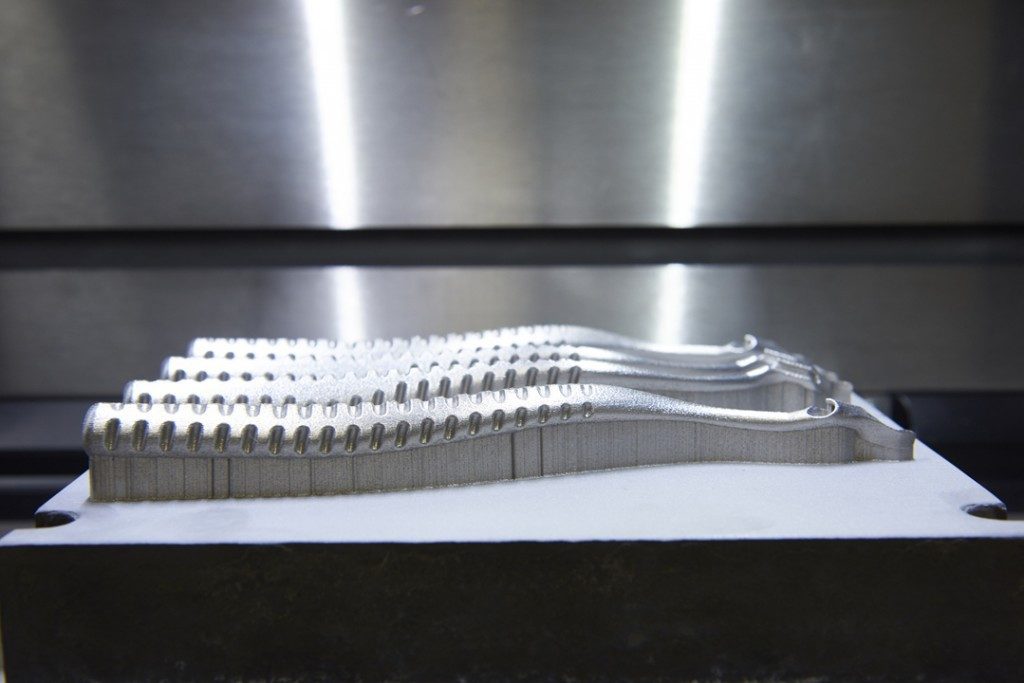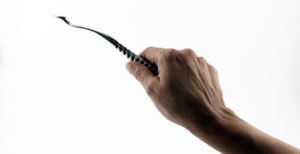 There are over 900 ligaments in the human body, each serving to support and connect hundreds of bones. The anterior cruciate ligament (ACL) is one of the most important ligaments connecting the tibia (shin bone) to the femur (thigh bone). It stabilizes the knee and prevents joint surfaces from shifting unnaturally. Regrettably, in the U.S. around 200,000 people incur partial or full ACL tears every year and out of those that are repaired, many may re-rupture and knees are never the same again. An ACL injury is an athlete’s nightmare. It is a huge disadvantage for runners and professional athletes in particular who constantly subject their knees to significant biomechanical stress. Dr. Dana Piasecki, a distinguished orthopedic surgeon at OrthoCarolina, in Charlotte, North Carolina, set out to improve the success rate of ACL reconstruction by modifying the standard surgical technique using a 3D printed metal surgical tool.
There are over 900 ligaments in the human body, each serving to support and connect hundreds of bones. The anterior cruciate ligament (ACL) is one of the most important ligaments connecting the tibia (shin bone) to the femur (thigh bone). It stabilizes the knee and prevents joint surfaces from shifting unnaturally. Regrettably, in the U.S. around 200,000 people incur partial or full ACL tears every year and out of those that are repaired, many may re-rupture and knees are never the same again. An ACL injury is an athlete’s nightmare. It is a huge disadvantage for runners and professional athletes in particular who constantly subject their knees to significant biomechanical stress. Dr. Dana Piasecki, a distinguished orthopedic surgeon at OrthoCarolina, in Charlotte, North Carolina, set out to improve the success rate of ACL reconstruction by modifying the standard surgical technique using a 3D printed metal surgical tool.
Challenge
When an ACL is torn it must be surgically removed and reconstructed with a graft using a ligament that is transplanted from the patient or a cadaver. Once healed, the graft is intended to function like a normal ACL. But unfortunately, due to limitations of the surgical technique, in most cases the graft cannot handle the same stress as the natural ACL once could.
Around 80 to 90 percent of ACL repair surgeries done annually in the U.S. are performed with a surgical technique known as the “transtibial technique”. It involves first drilling a tunnel through the front of the tibia head, which will serve as the tibial attachment point for the graft. Then the surgeon extends a drill though that tibial tunnel and up to the back of the femur to create a similar tunnel for the femoral attachment. The advantage of the transtibial technique is that it is relatively straightforward and is the familiar procedure that most surgeons are trained to perform. The technique is problematic however, in that entering the knee through the front of the tibia often results in the graft being attached to the femur as much as 5-10 mm away from the natural ACL attachment point. During normal patient activity, this can ultimately result in more extreme biomechanical strain on the graft and increased potential for graft failure. The alternative method, known as the “AM portal technique,” allows for somewhat better graft placement, but is much more difficult to perform and can create complications.
Dr. Piasecki started experimenting to find a new technique that would combine the principles of the relatively easier transtibial technique, with the improved graft positioning associated with the AM portal technique to ultimately improve both the ease and outcomes of ACL reconstruction.
“The main problem is doctors are using a straight drill to create the tibia and femur attachment points for the graft, but instrumenting through the rigid tibial tunnel limits where you can get on the femur. I realized I needed a procedure in which the drill is flexible and could be bent to follow the ligament’s normal path to impact the femur at the location and angle that anatomically mimics native ACL positioning. I then needed a tool that could be inserted into the inner knee space to grasp the flexible drill, steer it to the proper spot on the femur and hold it during the drilling process,” said Dr. Piasecki.
Furthermore, the tool design would need:
- to be moved in a non-linear fashion within a small cavity
- be strong enough to withstand non-linear forces
- be small enough so that the surgeon’s view of the inner knee space is not occluded
- have a method for grasping the drill tightly enough to bend and hold it while spinning at high speed
- have a provision for detaching the drill from the tool when the drilling was complete
- and be ergonomic and easy for the surgeon to grip throughout the procedure
Manufacturing this complex surgical instrument at a relatively low cost would also pose a challenge. “We are a brand new, self-funded company. The ability to produce low volumes of parts on demand is critical. We needed the freedom to make design changes and produce new parts at a low cost and on the fly,” said Jim Duncan, Dr. Piasecki’s business partner and CEO of DanaMed, Inc.
At the same time, the tool would come into contact with the inside of the human body, therefore requiring it be sterilizable and biocompatible. The maneuvering and drilling around bones would also require a strong and durable material that could maintain shape throughout several use cycles.
Solution
 Dr. Piasecki built the first mockups of the surgical tool called the Pathfinder by carving pieces of plastic by hand and testing them on anatomical models. When he settled on an initial hand-carved design, he went to Laser Design, a 3D scanning and design services company in Minnesota, to scan and convert the hand-carved part into a 3D CAD model to accelerate development.
Dr. Piasecki built the first mockups of the surgical tool called the Pathfinder by carving pieces of plastic by hand and testing them on anatomical models. When he settled on an initial hand-carved design, he went to Laser Design, a 3D scanning and design services company in Minnesota, to scan and convert the hand-carved part into a 3D CAD model to accelerate development.
“With 3D scanning and 3D printing technologies, we are able to turn the hand-whittled design into a functional CAD file and a 3D printed model within hours,” said Larry Carlberg, senior account manager at Laser Design. Laser Design 3D printed concept models in PC-ISO thermoplastic using Fused Deposition Modeling (FDM) to help further refine the design before moving into a more robust production materials and process.
FDM proved to be a great solution for proof of concept and initial testing. The Pathfinder featured an organic shape to match the anatomy of knee, including:
- an elongated, slim body section
- a slotted groove for capturing and holding a 2.2 mm diameter flexible drill, and for easily disengaging with a simple twist of the tool
- a curvilinear head section that would enable the surgeon to reference inner knee surfaces, turn and manipulate easily within the limited space, and rigidly hold position against bending and drilling forces
- Nitinol steel alloy for strength and biocompatibility
- and an ergonomic handle
There was also a need for a few design variations because even though knee anatomy is consistent from person to person, the left and right knees differ and children’s knees are considerably smaller.
After qualifying the concept with PC-ISO and FDM, Laser Design recommended manufacturing the production parts with Direct Metal Laser Sintering (DMLS) in Inconel 718 through Stratasys Direct Manufacturing. DMLS was the only manufacturing process that could build the intricate geometry in metal at a reasonable price point for low-volume production, and meet the necessary surface finish, oil resistance, and mechanical requirements. Larry Carlberg had partnered with Stratasys Direct Manufacturing on projects in the past and knew their manufacturing engineers had experience with DMLS and the complexities of the medical industry.
“Manufacturing the part with DMLS took some fine-tuning. We worked closely with Laser Design to refine our method for this particular application,” said John Self, project engineer at Stratasys Direct Manufacturing. The parts met the design specifications and tolerances immediately after they came off of the build platform, but through quality inspections and 3D CMM scanning, the team realized they were shrinking slightly as they cooled. On top of shrinkage, the parts had to be polished thus removing additional material.
Through design modifications and iteration, Laser Design and Stratasys Direct Manufacturing identified process controls to attain a repeatable design within a +/- 0.005” tolerance. Laser Design adjusted the design to account for size reduction during cooling and polishing. Stratasys Direct Manufacturing also made custom Nylon 12 PA fixtures using Laser Sintering to fit-check the parts and confirm tolerances. To finish the parts, Stratasys Direct Manufacturing removed the parts from the build platform with machining, polished each piece and sent them to Laser Design to be laser etched with identification numbers, left and right knee labels and the knee size.
Results
 DanaMed registered the Pathfinder ACL Guide with FDA, qualifying it as a Class 1 Medical Device certifying biocompatibility for an initial market release. DanaMed is committed to continuous improvement through implementing feedback from doctors during the initial market release to further enhance tool performance.
DanaMed registered the Pathfinder ACL Guide with FDA, qualifying it as a Class 1 Medical Device certifying biocompatibility for an initial market release. DanaMed is committed to continuous improvement through implementing feedback from doctors during the initial market release to further enhance tool performance.
“Being able to make design changes and 3D print new tools within days was extremely important to helping us perfect the design. We could get feedback from a doctor, make design adjustments and send an updated Pathfinder within a week – something we wouldn’t be able to do with investment casting or injection molding,” said Jim Duncan. In addition to the advantage of immediately implementing design adjustments at zero cost, 3D printing was about 97 percent cheaper per part when compared to investment casting the desired quantity of tools.
It will take 2 to 3 years to start seeing results from the initial patient procedures, but doctors are already finding the new technique much easier to conduct than traditional methods and have achieved a 95 percent success rate in anchoring the graft in the native ACL location. As DanaMed’s Pathfinder technique becomes widely adopted in the market and manufacturing volumes increase, they plan to continue production with DMLS and Inconel 718 for the awarded design freedom, cost savings, flexibility, and strength.
“This surgical tool has turned our vision of transforming ACL reconstruction into a reality faster and someday will hopefully eliminate repeat knee injuries to keep more athletes off the bench and on the field,” said Dr. Piasecki.
Check out the Pathfinder patent to learn more about this revolutionary surgical tool and procedure.
